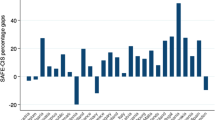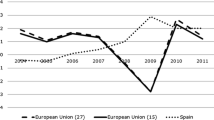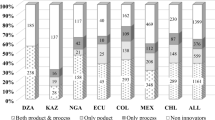Abstract
This paper examines innovation among very small firms and provides new insights into both internal and external determinants of patenting. Applying a non-linear panel data approach to about 160,000 observations on manufacturing firms in Sweden for the period 2000–2006, the following facts emerge: (i) in contrast to larger firms, innovation in micro firms with 1–10 employees is not sensitive to variation in internal financial resources, (ii) skilled labour is even more important for innovation among micro firms compared to other firms, (iii) affiliation to a domestically owned multinational enterprise group increases the innovation capacity of small businesses, (iv) small firms’ innovation is closely linked to participation in international trade and exports to the G7-countries, and (v) there is no statistically significant evidence that proximity to metropolitan areas, or presence in a specialized cluster, increases the innovativeness of the smallest firm.
Similar content being viewed by others
Notes
The USPTO grants about 80% of patent applications, the European Patent Office grants about 70% of patent applications, and in Sweden the grant rate for applications from operating commercial firms is close to 70%.
It should also be emphasized that the various propositions as regards the characteristics of innovating firms from the different strands of literature considered here are ‘open-ended’, such that the verification of hypotheses derived from one type of literature does not preclude hypotheses from the others.
Scherer (1999) maintains that R&D outlays in large established firms are often of such magnitude that “…they can be financed through routine cash flow and, if need be, can resort to outside capital sources willing to provide funds on full faith and credit without detailed inquiry into the specific uses to which the funds will be put” (ibid. p. 72). He argues further that this is one reason why empirical studies of internal cash flow and R&D among larger firms do not find systematic relationships.
MNEs have high ratios of R&D relative to sales, a large number of scientific, technical and other ‘white-collar’ workers as a percentage of their workforce, high value of intangible assets and large product differentiation efforts, such as high advertising to sales ratios (van Marrewijk 2002).
References
Acharya, R. C., & Keller, W. (2007). Technology transfer through imports. NBER Working Paper.
Acs, Z., Anselin, L., & Varga, A. (2002). Patents and innovation counts as measures of regional production of new knowledge. Research Policy, 31, 1069–1085.
Acs, Z. J., & Audretsch, D. B. (1988). Innovation in large and small firms: an empirical analysis. American Economic Review, 78, 678–690.
Acs, Z. J., & Audretsch, D. B. (1991). Innovation and size at the firm level. Southern Economic Journal, 57, 739–744.
Acs, Z. J., Audretsch, D. B., Braunerhjelm, P., & Carlsson, B. (2006). The knowledge spillover theory of entrepreneurship. CESIS WP, Royal Institute of Technology, Stockholm.
Acs, Z. J., Audretsch, D. B., & Feldman, M. P. (1994). R&D spillovers and recipient firm size. Review of Economics and Statistics, 76, 336–340.
Aghion, P., Van Reenen, J., & Zingales, L. (2009). Innovation and institutional ownership. NBER WP 14769.
Almeida, P., & Kogut, B. (1999). The localization of knowledge and the mobility of engineers. Management Science, 45, 905–917.
Andersson, M., & Johansson, B. (2008). Innovation ideas and regional characteristics—innovations and export entrepreneurship by firms in Swedish regions. Growth and Change, 39, 193–224.
Andersson, M., Lööf, H., & Johansson, S. (2008). Productivity and international trade—firm-level evidence from a small open economy. Review of World Economics, 144, 774–801.
Arundel, A., & Kemp, R. (2009). Measuring eco-innovation. UNU-MERIT Working Paper 2009-017.
Audretsch, D. B. (2002). The dynamic role of small firms—evidence from the US. Small Business Economics, 18, 13–40.
Audretsch, D. B., & Feldman, M. P. (1996). R&D spillovers and the geography of innovation and production. American Economic Review, 86, 630–640.
Baptista, R. (2000). Do innovations diffuse faster within geographical clusters? International Journal of Industrial Organization, 18, 515–535.
Barney, J. (1991). Firm resources and sustained competitive advantage. Journal of Management, 17, 99–120.
Bartel, A. P., & Lichtenberg, F. R. (1987). The comparative advantage of educated workers in implementing new technology. Review of Economics and Statistics, 69, 1–11.
Baumol, W. J. (2002). Entrepreneurship, innovation and growth: the David-Goliath symbiosis. Journal of Entrepreneurial Finance and Business Ventures, 7, 1–10.
Berman, E., Bound, J., Griliches, Z., & Machin, S. (1998). Implications of skill biased technical change: international evidence. Quarterly Journal of Economics, 113, 1245–1279.
Breitzman, A., & Hicks, D. (2008). An analysis of small business patents by industry and firm size. Small Business Administration, Office of Advocacy.
Brown, J. R., Fazzari, S. M., & Petersen, B. C. (2009). Financing innovation and growth: Cash-flow, external equity, and the 1990 s R&D boom. Journal of Finance, 64, 151–185.
Coe, D., & Helpman, E. (1995). International R&D spillovers. European Economic Review, 39, 859–887.
Cohen, W. (1995). Empirical studies in innovative activity. In P. Stoneman (Ed.), Handbook of the economics of innovation and technological change (pp. 182–264). Oxford: Blackwell.
Cohen, W., & Levin, R. (1989). Empirical studies of innovation and market structure. In R. Schmalensee & R. Willig (Eds.), Handbook of industrial organisation (Chap. 18, pp. 1060–1107). North-Holland.
Cohen, W., & Levinthal, D. (1990). Absorptive capacity—a new perspective on learning and innovation. Administrative Science Quarterly, 35, 128–152.
Crépon, B., Duguet, E., & Mairesse, J. (1998). Research, innovation, and productivity: An econometric analysis at the firm level. Economics of Innovation and New Technology, 7, 115–156.
Dachs, B., Ebersberger, B., & Lööf, H. (2008). The innovative performance of foreign-owned enterprises in small open economies. Journal of Technology Transfer, 33, 393–406.
Davidsson, P., Lindmark, L., & Olofsson, C. (1994). New firm formation and regional development in Sweden. Regional Studies, 28, 395–410.
de Jong, P. (2007). The relationship between capital investment and r&d spending: A panel cointegration analysis. Applied Financial Economics, 17, 871–880.
Duranton, G., & Puga, D. (2001). Nursery cities: Urban diversity, process innovation, and the life cycle of products. American Economic Review, 91, 1454–1477.
Ejermo, O. (2007). Regional innovation measured by patent data—does quality matter? CIRCLE Working Paper 2007-8.
Fang, W., Tian, X., & Tice, S. (2010). Does stock liquidity enhance or impede firm innovation? Working Paper, Rutgers University.
Fazzari, S. M., Hubbard, R. G., & Petersen, B. C. (1988). Financing constraints and corporate investment. Brookings Papers on Economic Activity, 1, 141–195.
Feldman, M. (1999). The new economics of innovation, spillovers and agglomeration—a review of empirical studies. Economics of Innovation and New Technology, 8, 5–25.
Granstrand, O., & Sjölander, S. (1990). The acquisition of technology and small firms by large firms. Journal of Economic Behavior & Organization, 13, 367–386.
Greenaway, D., & Kneller, R. (2007). Firm heterogeneity, exporting and foreign direct investment. Economic Journal, 117, 134–161.
Griliches, Z. (1990). Patent statistics as economic indicators—a survey. Journal of Economic Literature, 28, 1661–1707.
Griliches, Z. (1995). Econometric results and measurement issues. In P. A. Stoneman (Ed.), Handbook of the economics of innovation and technological change (pp. 52–89). Cambridge, MA: Blackwell.
Griliches, Z., Pakes, A., & Hall, B. H. (1988). The value of patents as indicators of inventive activity. NBER WP 2083.
Hall, B. H. (2005). The financing of innovation. In S. Shane (Ed.), Blackwell handbook of technology and innovation management. Oxford: Blackwell.
Harhoff, D. (2009). The role of patents and licenses in securing external finance for innovation. EIB papers volume 14 n°2/2009, European Investment Bank, Luxemburg.
Himmerlfarb, C., & Petersen, B. (1994). R&D and internal finance—a panel study of small firms in high-technology industries. Review of Economics and Statistics, 76, 38–51.
Hoover, E. (1937). Location theory and the shoe and leather industries. Cambridge: Harvard University Press.
Hulten, C. R. (2002). Total factor productivity: A short biography. In E. R. Dean, & M. J. Harper (Eds.), New developments in productivity analysis. National Bureau of Economic Research (Studies in Income and Wealth).
Jaffe, A. (1989). Real effects of academic research. American Economic Review, 79, 957–970.
Jaffe, A., Trajtenberg, M., & Henderson, R. (1993). Geographic localization of knowledge spillovers as evidenced by patent citations. Quarterly Journal of Economics, 63, 577–598.
Johansson, B., & Lööf, H. (2008). Innovation activities explained by firm attributes and location. Economics of Innovation and New Technology, 17, 533–552.
Keller, W. (2004). International technology diffusion. Journal of Economic Literature, 42, 752–782.
Kleinknecht, A., & Mohnen, P. (Eds.). (2002). Innovation and firm performance: econometric explorations of survey data. Basingstoke: Palgrave.
Klette, T. J., & Kortum, S. (2004). Innovating firms and aggregate innovation. Journal of Political Economy, 112, 896–1018.
Lööf, H., & Andersson, M. (2010). Imports, productivity and the origin markets–the role of knowledge intensive economies. World Economy, 33, 458–481.
Machin, S., & van Reenen, J. (1998). Technology and changes in skill structure: Evidence from seven OECD countries. Quarterly Journal of Economics, 113, 1215–1244.
Malerba, F., & Orsenigo, L. (1993). Technological regimes and firm behavior. Industrial and Corporate Change, 2, 45–74.
Marshall, A. (1920). Principles of economics. London: MacMillan.
OECD. (2009). Science, technology and industry scoreboard 2009. OECD Publishing. doi: 10.1787/sti_scoreboard-2009-en.
Ohlin, B. (1933). Interregional and international trade. Cambridge: Harvard University Press.
Patel, P., & Pavitt, K. (1991). Large firms in the production of the world’s technology: An important case of non-globalisation. Journal of International Business Studies, 22, 1–21.
Pavitt, K. (1984). Sectoral patterns of technical change—towards a taxonomy and a theory. Research Policy, 134, 343–373.
Penrose, E. T. (1959). The theory of the growth of the firm. New York: Wiley.
Phaffermayr, M., & Bellak, C. (2002). Why foreign-owned firms are different: A conceptual framework and empirical evidence for Austria. In R. Jungnickel (Ed.), Foreign-owned firms: Are they different? (pp. 13–57). Basingstoke: Palgrave Macmillan.
Rivera-Batiz, L., & Romer, P. (1991). International trade with endogenous technological change. European Economic Review, 35, 971–1001.
Rothwell, R. (1989). Small firms, innovation and technological change. Small Business Economics, 1, 51–64.
Scellato, G. (2007). Patents, firm size and financial constraints: An empirical analysis for a panel of Italian manufacturing firms. Cambridge Journal of Economics, 31, 55–76.
Scherer, F. M. (1999). New perspectives on economic growth and technological innovation. Washington: Brookings Institution Press.
Schumpeter, J. A. (1934). The theory of economic development (8th ed.). Cambridge: Harvard University Press.
Thoma, G., Torrisi, S., Gambardella, A., Guellec, D., Hall, B. H., & Harhoff, D. (2010). Harmonizing and combining large datasets—an application to firm-level patent and accounting data. NBER WP 15851.
van Marrewijk, C. (2002). International trade and the world economy. Oxford: Oxford University Press.
Vernon, R. (1966). International investment and international trade in the product cycle. Quarterly Journal of Economics, 80, 190–207.
Wagner, J. (2007). Exports and productivity—a survey of the evidence from firm level data. World Economy, 30, 60–82.
Author information
Authors and Affiliations
Corresponding author
Appendix
Rights and permissions
About this article
Cite this article
Andersson, M., Lööf, H. Small business innovation: firm level evidence from Sweden. J Technol Transf 37, 732–754 (2012). https://doi.org/10.1007/s10961-011-9216-9
Published:
Issue Date:
DOI: https://doi.org/10.1007/s10961-011-9216-9
Keywords
- Innovation
- Innovative firms
- Entrepreneurship
- Small firms
- Intellectual property rights
- Technology transfer
- Location




